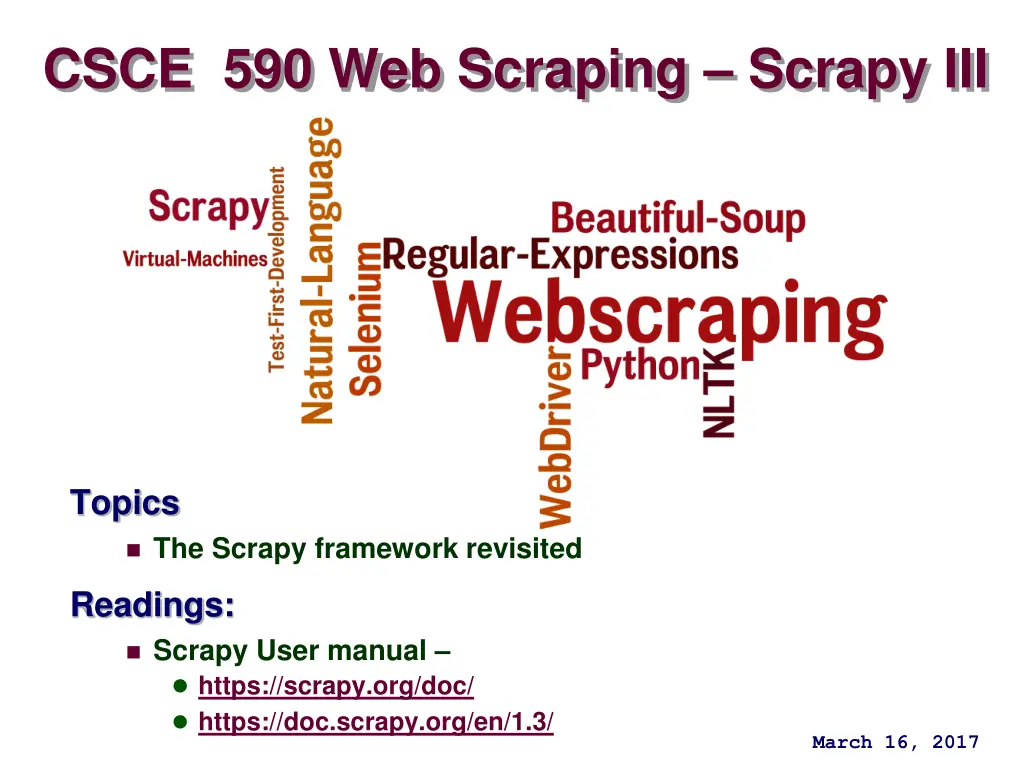
Web Scraping with Scrapy - Advanced Techniques and Best Practices
Explore advanced topics in web scraping using the Scrapy framework. Learn about debugging, auxiliary lambda functions for testing xpaths, integrating BeautifulSoup with Scrapy, building and running web spiders, and more. Enhance your skills and efficiency in data extraction from websites with this comprehensive guide.
Download Presentation

Please find below an Image/Link to download the presentation.
The content on the website is provided AS IS for your information and personal use only. It may not be sold, licensed, or shared on other websites without obtaining consent from the author. If you encounter any issues during the download, it is possible that the publisher has removed the file from their server.
You are allowed to download the files provided on this website for personal or commercial use, subject to the condition that they are used lawfully. All files are the property of their respective owners.
The content on the website is provided AS IS for your information and personal use only. It may not be sold, licensed, or shared on other websites without obtaining consent from the author.
E N D
Presentation Transcript
CSCE 590 Web Scraping Scrapy III Topics The Scrapy framework revisited Readings: Scrapy User manual https://scrapy.org/doc/ https://doc.scrapy.org/en/1.3/ March 16, 2017
Overview Last Time Scrapy yet again Review of some slides from lecture 14 before the break Quotes-spider, author-spider, login-then-scrape Scrappy commands: startproject, genspider, shell, crawl Spider templates Debugging example from Stackoverflow Yahoo/finance site analysis Today Scrapy one more time 2 CSCE 590 Web Scraping Spring 2017
Auxilliary lambda function to test xpaths Testing xpaths can be a lot of typing response.xpath('//ul[@class="directory-url"]/li') Instead define xp = lambda x: response.xpath(x).extract_first() Then instead you just have to type the path to test xp ('//ul[@class="directory-url"]/li') 3 CSCE 590 Web Scraping Spring 2017
https://scrapy.org Documentation pdf and online FAQ - https://doc.scrapy.org/en/1.3/faq.html 4 CSCE 590 Web Scraping Spring 2017
5 CSCE 590 Web Scraping Spring 2017
Using BeautifulSoup with Scrapy from bs4 import BeautifulSoup import scrapy class ExampleSpider(scrapy.Spider): name = "example" allowed_domains = ["example.com"] start_urls = ( 'http://www.example.com/', ) def parse(self, response): # use lxml to get decent HTML parsing speed soup = BeautifulSoup(response.text, 'lxml') yield { "url": response.url, "title": soup.h1.string } 6 CSCE 590 Web Scraping Spring 2017 https://doc.scrapy.org/en/1.3/faq.html
Build and run your web spiders pip install scrapy cat > myspider.py <<EOF import scrapy class BlogSpider(scrapy.Spider): name = 'blogspider' start_urls = ['https://blog.scrapinghub.com'] def parse(self, res): for title in res.css('h2.entry-title'): yield {'title': title.css('a ::text').extract_first()} next_page = res.css('div.prev-post > a::attr(href)'). extract_first () 7 if next_page: (next slide) CSCE 590 Web Scraping Spring 2017
def parse(self, response): for title in response.css('h2.entry-title'): yield {'title': title.css('a ::text').extract_first()} next_page = response.css('div.prev-post > a ::attr(href)'). extract_first() if next_page: yield scrapy.Request(response.urljoin(next_page), callback=self.parse) EOF scrapy runspider myspider.py 8 CSCE 590 Web Scraping Spring 2017
Deploy them to Scrapy Cloud pip install shub shub login Insert your Scrapinghub API Key: <API_KEY> # Deploy the spider to Scrapy Cloud shub deploy # Schedule the spider for execution shub schedule blogspider Spider blogspider scheduled, watch it running here: https://app.scrapinghub.com/p/26731/job/1/8 # Retrieve the scraped data shub items 26731/1/8 {"title": "Improved Frontera: Web Crawling at Scale with Python 3 Support"} {"title": "How to Crawl the Web Politely with Scrapy"} ... 9 CSCE 590 Web Scraping Spring 2017
Architecture Overview 10 CSCE 590 Web Scraping Spring 2017
The data flow in Scrapy is controlled by the execution engine, and goes like this: The Engine gets the initial Requests to crawl from the Spider. The Engine schedules the Requests in the Scheduler and asks for the next Requests to crawl. The Scheduler returns the next Requests to the Engine. The Engine sends the Requests to the Downloader, passing through the Downloader Middlewares (see process_request()). Once the page finishes downloading the Downloader generates a Response (with that page) and sends it to the Engine, passing through the Downloader Middlewares (see process_response()). The Engine receives the Response from the Downloader and sends it to the Spider for processing, passing through the Spider Middleware (see process_spider_input()). The Spider processes the Response and returns scraped items and new Requests (to follow) to the Engine, passing through the Spider Middleware (see process_spider_output()). The Engine sends processed items to Item Pipelines, then send processed Requests to the Scheduler and asks for possible next Requests to crawl. The process repeats (from step 1) until there are no more requests from the Scheduler. 11 CSCE 590 Web Scraping Spring 2017
Xpath >>> response.xpath('//title') [<Selector xpath='//title' data='<title>Quotes to Scrape</title>'>] >>> response.xpath('//title/text()').extract_first() 'Quotes to Scrape' 12 CSCE 590 Web Scraping Spring 2017 https://doc.scrapy.org/en/1.3/




